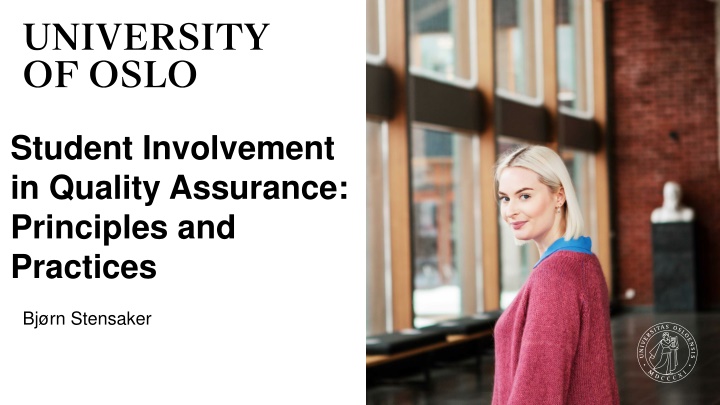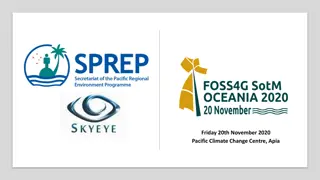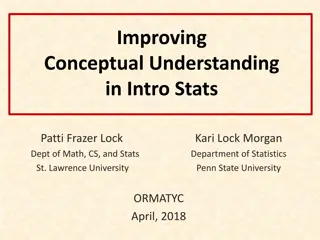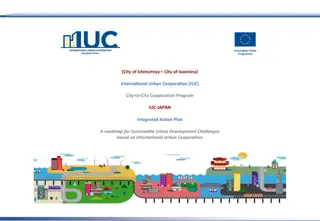
Student Involvement in Quality Assurance: Key Arguments and Roles
Explore the importance of student involvement in quality assurance (QA) in higher education, including key arguments advocating for students' participation and the various roles students can have at both the QA agency and university levels. Delve into key dilemmas in designing student involvement, such as the active versus passive participation of students and the treatment of students as either a uniform group or diverse stakeholders.
Download Presentation

Please find below an Image/Link to download the presentation.
The content on the website is provided AS IS for your information and personal use only. It may not be sold, licensed, or shared on other websites without obtaining consent from the author. If you encounter any issues during the download, it is possible that the publisher has removed the file from their server.
You are allowed to download the files provided on this website for personal or commercial use, subject to the condition that they are used lawfully. All files are the property of their respective owners.
The content on the website is provided AS IS for your information and personal use only. It may not be sold, licensed, or shared on other websites without obtaining consent from the author.
E N D
Presentation Transcript
Student Involvement in Quality Assurance: Principles and Practices Bj rn Stensaker
What are key arguments for student involvement in QA? Students invest time and money in higher education, and it is fair to include them in key processes addressing the quality of their education (the market perspective) Students invest time, energy and devotion in higher education, and they are partners to academic staff in developing knowledge (the academic perspective) Students could bring fresh ideas as to how teaching (and learning) could take place (the innovation perspective) Students are the only experts in being a student Page 2
What roles may students have in QA? (1) QA agency level Represented in the governance body of the agency Part of evaluation/accreditation committees Providing input to evaluation/accreditation committees (taking part in surveys, being interviewed, etc.) Contributing to the design of national evaluation and accreditation schemes through their national interest organizations Recipients of evaluation/accreditation results Page 3
What roles may students have in QA? (2) University level Represented in the governance body(ies) of the university Part of internal evaluation committees/Represented in the internal quality assurance system Providing input to evaluation committees through surveys and interviews Contributing through student evaluations of teaching Setting up their informal QA mechanisms (rate your teacher, etc.) Page 4
Key dilemmas in designing student involvement (1) Students as active or passive participants? Are we inviting students as co-creators or assigning them a task? (Bovill et al. 2021) Students representation or students as representatives? Who are the students we invite speaking for should they be elected, appointed, and what are the implications (Matthews & Dollinger 2023) Students participating in a planned process or accepting uncertainty wrt the outcome of the participation? Student involvement could be quite dynamic (Holen et al. 2021) Page 5
Key dilemmas in designing student involvement (2) Treating students as a uniform group or treating them as diverse stakeholders? Students are more diverse than ever, and their view on `quality` may be very different (Jungblut et al. 2015) Treating students as partners or treating them as a customer? Should we use students to `rate a product` or helping to develop it (Naylor et al. 2020) Page 6
Solving dilemmas regarding student participation is also a matter of context (Tanaka, 2019) Student involvement is dependent on political and national context Empirically, there is much diversity around the world as to whether and how students are involved in QA procedures Diversity is found wrt legal basis, organizational set-up, training and competence building, etc. Page 7
Case 1: European standards and guidelines for QA focuses especially on student involvement at agency level (a legalistic approach) ESG Standard 1.3: Institutions should ensure that the programmes are delivered in a way that encourages students to take an active role in creating the learning process, and that the assessment of students reflects this approach. ESG Standard 2.2: . Stakeholders should be involved in its design and continuous improvement. ESG Standard 2.4: External quality assurance should be carried out by groups of external experts that include (a) student member(s). ESG Standards 3.1: Agencies should involve stakeholders in their governance and work. Page 8
Case 2: Sparqs Scotland building an institutionalized structure for student voice in QA SPARQs = Student partnerships in quality Scotland a public agency supporting student involvement Aims at supporting students, institutions and the sector in stimulating student involvement Offers training for students having various roles in QA, and functions as a pipeline for talent involved in QA processes Offers practices and advice for institutions wanting to strengthen student involvement Page 9
What is the added value of student involvement in QA? Increased legitimacy embedding the voices of students in a systematic way The alternative is student activism A way to work to enhance the outcomes of HE are student- centered approaches to teaching and learning possible without student involvement? Other benefits include increased student motivation; strengthened sense of belonging; enhanced student-staff relationships (Matthews & Dollinger, 2023) Page 10
A simple model conceptualizing different modes of student involvement (Holen et al 2021): Internal pressure for student participation External pressure for student participation Student as an apprentice Student as follower of political agendas Actors share norms, values and objectives Student as a democratic participant Student as a customer/consumer Actors have conflicting norms, values and objectives Page 11
Conclusions Student involvement in QA imply clarifying some basic questions as to what the desired outcome of the process should be Student involvement imply many different roles and responsibilities, and could have incremental or disruptive impact A key question is to develop a theory of change how is change expected to take place (Bovill et al. 2021) Plan for the unexpected student involvement tend to create new dynamics which can also drive new ideas Page 12
Selected literature: Bovill, C., Matthews, K.E. & Hinchcliffe, T. (2021) Student partnership in assessment. London: AdvanceHE. Holen, R., Ashwin, P., Maassen, P. & Stensaker, B. (2021) Student partnership: exploring the dynamics in and between different conceptualizations, Studies in Higher Education, 46(12), 2726-2737. Jungblut, J., Vukasovic, M. & Stensaker (2015) Student perspectives on quality in higher education. European Journal of Higher Education, 5(2), 157-180. Matthews, K.E. & Dollinger, M. (2023) Student voice in higher education: the importance of distinguishing between student representation and student partnership. Higher Education, DOI: 10/1007/s10734-022-00851-7. Matthews, K.E. (2017) Five propositions for genuine students as partner practice. International Journal for Students as Partners. 1(2), 64-81. Mercer-Mapstone, L. & Bovill, C. (2019) Equity and diversity in institutional approaches to student-staff partnership schemes in higher education. Studies in Higher Education, DOI: 10.1080/03075079.2019.1620721. Naylor, R., Dollinger, M., Mahat, M. & Khawaja, M. (2020) Students as customers versus as active agents: conpeptualizing the student role in governance and quality assurance. Higher Education Research & Development, DOI: 10.1080/07294360.2020.1792850. Tanaka, M. (2019) Student engagement and quality assurance in higher education. London: Routledge. Page 13






















